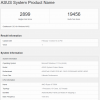and my 2 256 thread systems ? I can't compare them. If what it does only works for middle of the line desktop workloads, what good is it ?
If my understanding of the new calculation is correct, you can compare them between GB6 runs.
They aren't 'ratios' or anything like that. The multicore workloads are based on real life performance, and scores are weighted as such. Zen 4 and RPL-S happen to score well because they have either several high frequency cores (Zen 4) or a mix of extremely high frequency cores and a bunch of slow ones (RPL-S). Either way they both bruteforce enough to get the job done.
Ignore benchmarks and specialty applications for a moment. Look at the workloads they run. Run them manually, you'll understand.
I thought their choice of calibration using a modern CPU was a bit odd, but given that GB5 was launched 5 years ago, I get it. 5 years from now, desktop CPUs will look very different.
Zen 4 Threadripper will very likely tell the complete story. A combination of high clocked Zen 4 cores should, in theory, beat out the 7950X significantly.
I do hope that someone here is able to play with it a bit more. If not, I hope to this weekend. I suspect that once you start to eliminate variables (frequency and/or small cores) you will see why things actually add up.
I am in no way defending them either. I thought GB5 was a great benchmark, but previous GB versions weren't. The new benchmark is unproven. It likely will be soon-ish.













